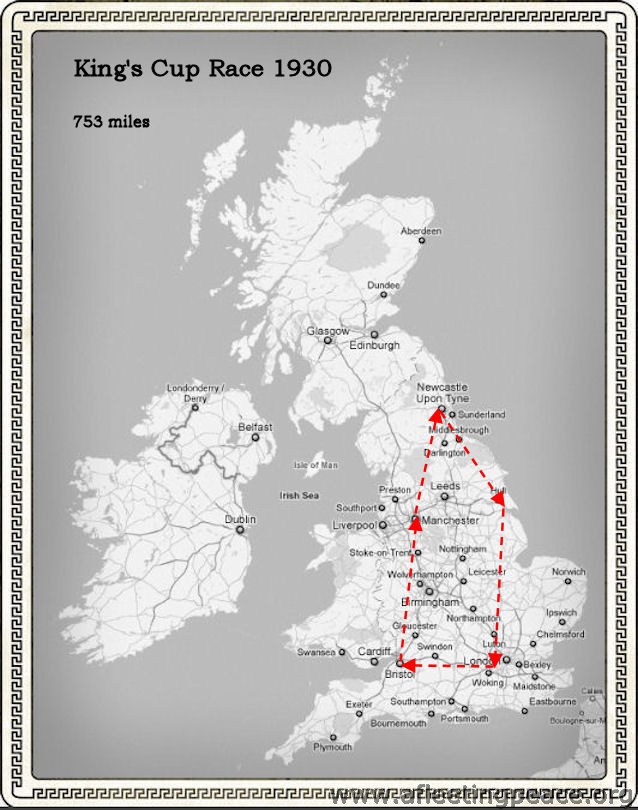King's Cup - 1930
-
-King's Cup - 1930
Click here to see the newsreel!
(but don't forget that Winnie Brown was not really 22, having being born in 1899...)
Winsome Winnie with Ron Adams 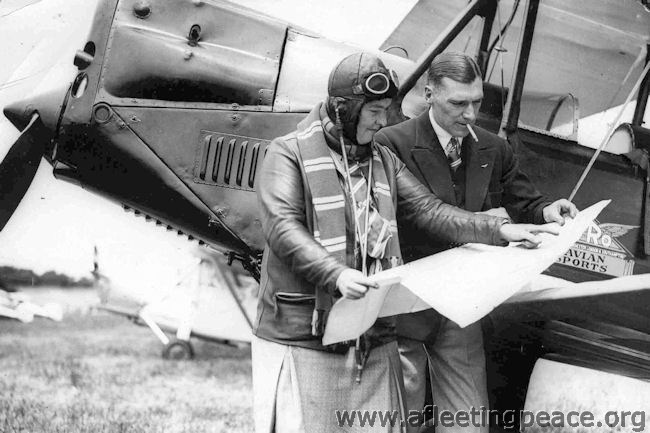
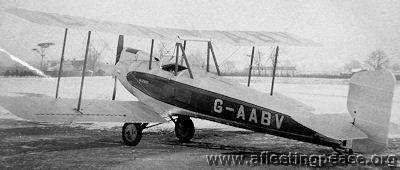
Norman Blackburn's Bluebird (pictured the year before, when Leonard Slatter flew it to Durban) and some of the other also-rans... 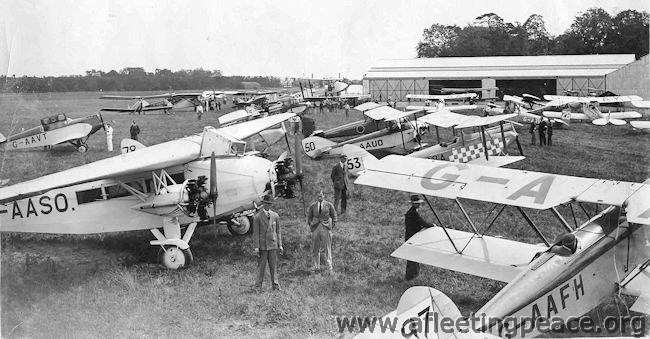
Saturday, July 5, 1930. Hanworth
Weather: fine
Story of the Race: The largest field for any King's Cup Race, and the first woman winner.
Pilot Aircraft Race No Fate Mr Francis S Symondson D.H.60M Moth G-AARU 1 Mr Ian R Parker D.H.60G Moth G-EBYV 2 Mr Arthur GG Marshall D.H.60G Moth G-EBYZ 3 Lieut Caspar John, RN Avro 594 Avian III G-EBWU 5 Mr E Fulford D.H.60M Moth G-AAWU 6 Mr Derek S Schreiber D.H.60G Moth G-AAEW 7 Mr James B Buckley D.H.60 Moth G-EBQW 8 16th Capt C D Barnard D.H.80a Puss Moth G-AAXW 9 13th Flt-Lt Richard LR Atcherley Segrave Meteor G-AAXP 10 retired at start - starboard engine fuel problem Lieut-Col Andrew H Gault D.H.60G Moth G-AAGA 12 Mr Thomas H Naylor D.H.60G Moth G-AABO 13 Mr W A Dudley Spartan Arrow G-AAWZ 14 Mr George Vlasto D.H.60X Moth G-EBVD 15 retired before Newcastle Mr W H Sutclifle D.H.60 Moth G-EBOT 16 retired before Newcastle Lieut-Col Louis A Strange Simmonds Spartan G-AAGN 17 retired after Hull Mr Carill S Napier Westland Widgeon III G-AADE 18 Capt H H Balfour Spartan Arrow G-ABBE 19 Capt Maxwell H Findlay D.H.80a Puss Moth G-AAFA 20 Flt-Lt Tommy Rose Blackburn Bluebird IV G-AACC 21 6th Capt Norman WG Blackburn Blackburn Bluebird IV G-AABV 22 retired at Hull Hon Lady Mary Bailey D.H.60G Moth G-AAEE 23 F/O H T Andrews Simmonds Spartan G-AAGO 24 F/O J FX McKenna Spartan 3-seater G-ABKJ 25 Capt Hubert S Broad D.H.80a Puss Moth G-ABBH 26 9th Flt-Lt G GH Du Boulay Blackburn Bluebird IV G-AATO 27 Sqn-Ldr Leonard H Slatter Blackburn Bluebird IV G-AAVG 28 retired after Hull Colonel the Master of Sempill Blackburn Bluebird IV G-AAIR 29 retired at Hull F/O John W Gillan Blackburn Bluebird IV G-AAOI 30 Flt-Lt Henry RD Waghorn Blackburn Bluebird IV G-AATN 32 3rd Sqn-Ldr David S Don Hawker Tomtit G-AALL 33 18th
Mr Walter L Runciman D.H.60X Moth G-EBWT 35 Sqn-Ldr Harold A Probyn Westland Widgeon III G-EBRQ 37 Mr Austin B Ferguson D.H.60G Moth G-AAEF 39 Flt-Lt Frank G Gibbons Simmonds Spartan G-AAMG 40 F/O S A Thorn Avro Avian IV G-AAHJ 41 Mr Alan BH Youell Desoutter I G-AATK 42 retired at Castle Bromwich F/O Joseph Summers Vickers 172 Vellore III G-AASW 43 Capt W Lawrence Hope D.H.60G Moth G-AAHP 44 10th Flt-Lt J R Addams Spartan Arrow G-AAWY 45 Mr E G Hordern D.H.80a Puss Moth G-AAXT 46 retired at Manchester Mr John WP Chalmers D.H.60G Moth G-AAYY 47 Flt-Lt Herbert V Rowley Blackburn Bluebird IV G-AAUW 48 retired before Newcastle Mrs Christina M Young D.H.60G Moth G-ABAE 49 Flt-Lt J FT Barrett Robinson Redwing G-AAUO 50 retired Manchester - compass trouble Maj Charles EM Pickthorn D.H.60G Moth G-AAWR 51 Mr Richard Ince D.H.60G Moth G-AAKI 52 Flt-Lt J B Allen D.H.60G Moth G-ABBA 53 Mr Philip A Wills D.H.60 Moth G-EBOI 54 Miss Winifred S Brown Avro 594 Avian III G-EBVZ 55 Winner F/O Haliburton H Leech D.H.60G Moth G-AALK 56 Capt the Hon Frederick E Guest Hawker Tomtit G-ABAX 57 12th Mr John D Irving D.H.60G Moth G-AADA 58 Flt-Lt T B Bruce Avro 594 Avian G-EBQN 59 8th Flt-Lt D V Carnegie D.H.60G Moth G-AAEL 60 retired at Newcastle F/O Phillip EG Sayer Desoutter 1 G-AAPY 61 Capt Edgar W Percival Hendy 302A G-AAVT 63 Miss Winifred E Spooner Southern Martlet G-AAYZ 65 14th Lieut L G Richardson, RN D.H.60 Moth G-EBPQ 66 17th Capt Robert G Cazalet Westland Widgeon IIIa G-EBRM 67 19th Capt Charles B Wilson Desoutter II G-AAZI 68 retired at Newcastle - sustained damage of some sort Capt T Neville Stack Avro Avian 625 Monoplane G-AAYW 69 retired at Newcastle Capt James LN Bennett-Baggs Avro 621 Tutor G-AAKT 70 forced landing in Buckinghamshire Flt-Lt Sydney LG Pope Avro 619 V G-AASO 71 retired Manchester - one engine failed to start Sqn-Ldr Harold A Whistler D.H.60M Moth G-AAYG 73 Flt-Lt Edward H Fielden D.H.75a Hawk Moth G-AAUZ 74 7th Mr Geoffrey R de Havilland D.H.60M Moth G-AASL 75 Mr Alan S Butler D.H.60M Moth G-AAXG 76 2nd Mrs Lois Butler D.H.80a Puss Moth G-AAXL 77 4th Capt R Douglas D.H.60M Moth G-ABAI 78 Capt Geoffrey de Havilland D.H.80a Puss Moth G-AAXO 79 retired at Manchester Lieut-Comm Glen Kidston, RN D.H.80a Puss Moth G-AAXZ 80 11th Mr Geoffrey Goodwin Avro 616 Avian IVM G-AACV 82 retired at Manchester - plug trouble Mr D S Green Avro 616 Avian IVM G-AABS 83 5th Flt-Lt F B Tomkins Avro 625 Avian Monoplane G-AAYV 84 retired at Manchester Mr J C Cantrill Avro 616 Sports Avian G-AAYU 85 forced landing in Gloucestershire (turned over) Miss Diana C Guest D.H.80a Puss Moth G-AAZP 86 retired at Manchester Capt Ian C Maxwell D.H.60G Moth G-AAJS 87 retired at Woodford Mr G P Fairbairn D H.60G Moth G-AAJO 88 Sqn-Ldr Augustus H Orlebar Blackburn Bluebird IV G-AAUU 89 20th Flt-Lt John Oliver Avro 616 Sports Avian G-AAWI 91 forced landing in Gloucestershire Mr Alfred CM Jackaman D.H.60G Moth G-AADX 92 Sqn-Ldr John W Woodhouse Blackburn Bluebird IV G-AAVF 93 Mr Henry NS Norman D.H.60G Moth G-AAHI 94 Mr A L Mortimer ABC Robin G-AAID 95 forced landing Old Sarum Mr H A Presto Patnall Elf G-AAFH 97 15th Mr Frederick G Miles Southern Martlet G-AAVD 98 retired before Newcastle Mr Michael DL Scott D.H.60G Moth G-EBXG 100 retired after Hull Capt G A Pennington D.H.60G Moth G-AASG 101 Starters: 88 (out of 101 entrants). Finishers: 61
Did not start:
Capt G Fane Comper Swift G-AAZF 4 Mr W Lawrence Hope Puss Moth G-AAYD 11 Mr Loel Guiness Blackburn Bluebird IV G-AAUV 31 Mr R WR Trafford Moth G-ABAM 34 Mr L S Snaith Comper Swift G-AARX 36 This, the prototype Swift, first flew at Hooton Park in January 1930.
"en route to Hanworth his engine started losing oil, so Leonard decided to put down in a farmer’s field. Nick was contacted and so important was this event to promote his aircraft that armed with tools and a mechanic they set off to locate the stricken Swift. Unfortunately the problem was too difficult to solve and The Comper Swift was scratched from the race."
Mr F AI Muntz Moth G-EBQH 38 Flt-Lt J S Chick Arrow Active - 62 Mr H J Andrews Blackburn Bluebird IV G-AATS 64 Mr R S Rattray Moth G-EBZZ 72 crashed his Moth the other week Mr A A Nathan Moth G-AALJ 81 Mr C L Pashley/Flt-Lt F J Fogarty Blackburn Bluebird IV G-AASV 90 Lord MA Douglas-Hamilton Blackburn Bluebird G-AAOB 96 Miss F M Wood Moth G-AAGI 99 -
-The Aviators
The Aviators
-
Andrews, Hugh Thornley
F/O Hugh Thornley Andrews  1930
1930b 28 Jul 1907, Swansea, Glamorgan
RAF 1925-1930
He entered for the 1929 King's Cup Race, but withdrew before the start
Chief Test Pilot for Spartan Aircraft Co Ltd, Woolston, Southampton, 1 Feb 1930 to 8 Sep 1931
He made two entries for the 1930 King's Cup Race, in Bluebird G-AATS and Spartan G-AAGO, and eventually flew in the latter but was unplaced.
He then entered Spartan Arrow, G-AAWZ in the Europa Rundflug 3-week Air Race, 16 Jul-8 Aug 1930
Test Pilot for Fairey Aviation Co, Hamble, Nov 1931 to Dec 1933
RAF in WWII, then Sales Manager for Cunliffe-Owen Aircraft Ltd, 1946-52
Research: thanks to Steve Brew
-
Atcherley, Richard Llewellyn Roger
F/O (later Flt-Lt) (Sir) Richard Llewellyn Roger Atcherley KBE, CB, AFC
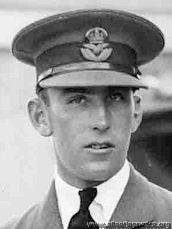 photo: 1929, aged 25
photo: 1929, aged 25Batchy', twin brother of David, b. 12 Jan 1904
1929 Schneider pilot and later Air Marshall in the RAF and Chief of Air Staff for the Pakistan Air Force. Put on a bit of weight later on, and ended up as Sales Director for Folland Aircraft.
Died 18 Apr 1970.
-
Barnard, Charles Douglas
Capt Charles Douglas Barnard
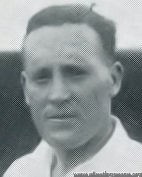 photo: 1930
photo: 1930Personal pilot to the Duchess of Bedford, 'ribald and golden-haired'.
b. 8 Dec 1895 in London; his father, Charles Gilbert Barnard, was a master printer (and not related to Franklyn Barnard's father). He learnt to fly in 1915 with the RFC. After WWI, became a test pilot for Sopwith, then a pilot with the de Havilland Airplane Hire Service after meeting Alan Cobham, then their chief pilot, in Spain.
In July 1920, he was convicted of manslaughter, for killing an elderly man in a car accident in which he failed to stop, and didn't report; "Charles Barnard (24), a demobilised airman from Watford whose machine was brought down in flames in France, was charged with the manslaughter of Alfred Sharp on the night of May 2, by knocking him down whilst driving a motor-car. A button, answering the description of other buttons from the deceased's coat, was found between the bonnet and mudguard of the accused's car. He was remanded, bail being refused." It also turned out that his driving licence had lapsed at the time, and he hadn't renewed it until some days after the accident.
He was given 4 months imprisonment in the 'Second Division' (such prisoners were kept apart from other classes of prisoners, received more frequent letters and visits and wore clothes of a different colour). The Judge said there was "too much reckless driving by people who served in the war. Their war services were no consolation to bereaved relatives."
Settling down a bit after that, he was the pilot in 1923 when an aeroplane belonging to the de Havilland Hire Service was used to ferry Commander Bristow to have a look at an Italian ship, the D'Aosta, which had become stranded in Malta. It was the first time the flight had been made, and it took over 14 hours, mainly (Charles complained) because the authorities in Pisa insisted on a deposit of 15% of the value of the machine.
One of his other jobs for the de Havilland Hire Company was to fly G-EBGT 'Nulli Secundus', a perfectly good D.H.9c, while a certain Captain Spencer jumped out of it - see the video here.
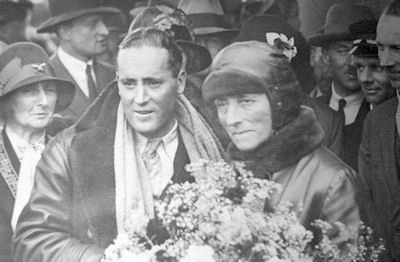
His first long-distance flight with the Duchess of Bedford was a tour in 1927 from her home in Woburn Abbey to France, Spain and North Africa, covering 4,500 miles in 3 weeks. Two years later, he piloted her Fokker monoplane, the 'Spider' to India and back, 10,000 miles in 88.5 hours; the RAeC gave him their Gold Medal for the year. It wasn't their first attempt at the flight to India and back - a year before they had tried the same thing, but problems with the propellor meant that the Duchess had had to come back by steamer from Karachi (which at the time was in India, of course).
In 1928, described as a 'flying man', he was cited as the co-respondent in a divorce case. At the time, he and Mrs Melita Erna May were living together at his place in Monmouth Rd, Bayswater; they got married in December.
In 1930 he and the Duchess made another record flight from London to Cape Town and back, 19,000 miles in 20 days, and he again flew to Malta and back in Puss Moth G-AAXW in 2 days: see the videos here :http://www.britishpathe.com/video/to-the-cape-and-back-in-19-days and here: http://www.britishpathe.com/video/malta-and-back-in-2-daysIn 1931, he was seriously injured when he, Lord Lovelace and their American mechanic crashed near Tripoli, as they were flying to Kenya.His marriage didn't last; Melita left him in 1933 and filed for divorce. He was in court again, when he was accused of assault by Mr Thomas Birks, a solicitor's clerk. Charles, described as a 'civil pilot wth a distinguished record' tried to persuade his wife to return to him, and somehow thought that a revolver might help; Mr Birks tried to intervene, and alleged that Charles fired a shot at him. Charles, however, won the case and was awarded 15 guineas damages (although he had asked for 50).He then formed his 'Flying Circus' - 8 aeroplanes which toured India in 1933 "giving displays of formation and stunt flying to over a million people who have never seen such a thing before... Joy rides will be offered to people at a small charge".He was back again by popular request in 1935, as co-respondent in yet another divorce case - this time with Mariska Marguerite Spurr.d. August 7, 1971. Only 2 people went to his funeral... -
Barrett, John Francis Tuffnell
Flt-Lt John Francis Tuffnell Barrett 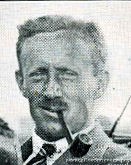
photo: 1930, aged 32
From Surrey. DSO and bar, DFC.
Died in WWII: 3rd September 1941, when a Group Captain, RAF
buried in Berlin's WWII Cemetery
-
Broad, Hubert Stanford
Capt Hubert Stanford Broad MBE AFC
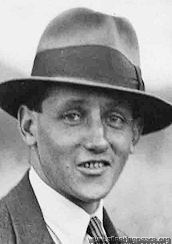 photo: 1930, aged 33
photo: 1930, aged 33b. 18 (or 20) May 1897
shot through the neck in WWI by one of Richtofen's Red Circus pilots; [c.f. Angus Irwin]; second in Schneider 1925, to Jimmy Doolittle.
In 1928, he spent possibly the most boring 24 hours of his life by beating 'all existing figures' for long endurance flights in light aeroplanes (unfortunately there was no official 'record' to beat as such, the FAI not recognising such things). His log makes, um, rivetting reading:
--0--0--0--0--0--0--0--0--0--0--
5:30pm: Hendon
7:40pm: Gloucester
8:30pm: Coffee and sandwiches
11pm: Over Central London, 3,000ft; watched theatre crowds leaving
Midnight to dawn: Remained over Edgeware
2:30am: second meal
4:10am: First signs of dawn
5:10am: Biggin Hill. Saw night bomber in air
...
Noon: Stamford. Very sleepy
4:30pm: Ipswich
--0--0--0--0--0--0--0--0--0--0--
Having trimmed the controls, Hubert settled down and read 3 complete novels 'to relieve the boredom'.
When he finally landed, he he said that he was very stiff with cramp, and promptly went home to sleep. His Moth still had 12 gallons of fuel, so it could have kept going for another 4 1/2 hours...
He was named as co-respondent in Beryl Markham's divorce in 1939.
de Havillands test pilot until 1935 (Bob Waight succeeded him) - broke the world's speed and height records for light aircraft in the original monoplane Tiger Moth, then joined RAE Farnborough; Hawker test pilot post-WWII; died 1975
FLIGHT MARCH 28TH, 1946
No. 2. CAPT. H. S. BROAD, Senior Production Test Pilot, Hawker Aircraft Co.
FOR sheer wealth of flying experience it is doubtful whether there is another pilot in the world to equal Hubert Broad. He has flown everything from diminutive single-seaters to multi-engined--bombers, and including a number of out-and-out racing aircraft. His logbooks, of which he has filled some nine or ten, total over7,500 hours' flying time and 182 separate types. These are honest types—not modifications or different mark numbers of the same aircraft. Many of these he has also flown as seaplanes. Broad, at the age of nineteen, learnt to fly at the Hall School of Flying at Hendon in 1915. The aircraft on which he made his first flight (there was no dual, a pupil did straights across the airfield until he felt it was safe to do a circuit)was the single-seater Caudron with35 h.p. Y-type Anzani engine. Believe it or not, with this tiny horsepower the Caudron occasionally was made to stagger into the air with two people on board, but the passenger had to sit on the wing by the side of the nacelle.
Early Days
The end of 1915 found Broad in the R.N.A.S. at Eastchurch, and he was on the very first course at Cranwell, which was then a R.N.A.S. establishment rejoicing in the name of H.M.S. Daedalus. His first tour of duty at the front was with No. 3 Squadron at Dunkirk. He was among a number of pilots lent by the R.N.A.S. to the R.F.C. No. 3 Squadron flew Sopwith Pups, and it was while he was on one of these, escorting a bombing raid by 90 h.p. R.A.F.-engined B.E.s, that he was shot through the neck by one of Richtofen's later Goering's—Red Circus pilots.
On recovery he spent a while as an instructor at Chingford and then went for his second tour of operations with No. 46 Squadron, who flew Sopwith Camels. The end of the 1914-18 war found Broad instructing at the Fighter Pilots' Flying School at Fairlop.
Peace found him, as it found so many other young fellows ,with the ability to fly aircraft superbly and no other means of making a living. But a good living could be made by joy-riding in the early 1920's. First he joined the Avro Company, who were running joy-riding in a fairly big way, and in 1920 went to the Adiron Lakes in America with two Avro 504 seaplanes. These two aircraft saw their last days in Long Island, where they were completely wrecked by an autumn gale.
By the next year he was back in England competing in the Aerial Derby air race round London on a Sopwith Camel. He finished 6th.In October, 1921, Broad joined de Havillands. Those who know this great concern now will smile to learn that when it started in those days it consisted entirely of two fabric hangars and a hut at Stag Lane. If memory serves, the capital of the company at that time was £100.
The D.H. series numbers, which started in the Aircraft Manufacturing Co. Ltd., were carried on in this new firm, and Broad flew every one of the D.H. designs from the D.H.27 to the D.H.90. In the same period he did a lot of test flyingfor other aircraft constructors.
He did the W.10, Handcross, Hendon, and some others for Handley Pages, the Parnall Pipit and the Saunders A. 10 fighter. On the Gloster Grebe he ran into wing flutter for the first time (this trouble, in those days, was on a par with the compressibility troubles we have now).
Seaplane testing
Another big job he did was most of the development work on the Gloster II and III racing seaplanes. Over a period I used to go with him to Felixstowe regularly. As a Press man I was forbidden the precincts of the R.A.F. seaplane station, but there was a perfectly good Great Eastern Railway pier alongside the station. I used to climb over the fence and watch the proceedings from the pier head. Broad nearly lost his life there one day in October,1924. As he was landing the Gloster II a forward strut to the floats collapsed, and the aircraft turned completely over. Mrs. Broad was watching from the shore, and it seemed a very long time before Hubert appeared on the surface.
In 1925 Hubert Broad flew the Gloster III racing seaplane in the Schneider Trophy contest which was held that year over Chesapeake Bay in America. This was the race in which Henri Biard, flying the SupermarineS.4—the true forerunner of the Spitfire—crashed in the water with wing flutter. Broad finished this race second to Jimmy (now General) Doolittle. That must have been a vintage generation, because many names from that period have found their way into the high-spots of this last war.
With the advent of the D.H. Moth in all its variants, Broad was to be seen performing aerobatics at most flying club meetings and entering many of the races. These included the King's Cup Race, which he won in 1926. He was flying a delightful Cirrus I Moth, which was a study in ivory and red. His average speed over the whole732 miles was 90.4 m.p.h. His piece de resistance in aerobatics was a perfectly formed big loop, the base of which was only some 150ft from the ground. It was a joy to behold, but very dangerous to perform. Broad had sufficient sense to realise this and sufficient courage to stop doing it.
"Hooked"
It was during an aerobatic show that Hubert had his closest shave in a life packed with incident. And it was so simple. Flying a D.H. Tiger Moth with no one in the front seat, he did a slow roll—a stunt at which he was a master. The safety belt in the empty cockpit was loosely done up. While the Moth was inverted the belt hung down and, as the aircraft turned the right way up again, the belt came back over the joy-stick. The result was that Broad had only about 1 1/2 inches of stick movement; but, nothing daunted, he made a sort of tail-up, seaplane landing. In this connection it is to be remembered that there were no lovely 2,000-yard runways on which to this sort of thing. In those days there was not a single runway available in Britain; not even for the take-off of over-loaded aircraft for long-distance records!
Another unhappy moment occurred when he found the tail trim (the incidence of the whole tailplane was adjustable)of a D.H.34 had been connected in reverse. By a good deal of jockeying he managed to get into Northolt. On yet another occasion a careless mechanic left a screwdriver jammed in the chain and sprocket of the rudder actuating gear. This necessitated a down-wind, crosswind, finishing up into-wind landing at Hendon airfield, because that was a bit bigger than Stag Lane.
One of the prettiest little aircraft he ever flew was the original D.H. Tiger Moth monoplane. This was tailored exactly to fit Broad. Physically he is not of big stature and few other pilots could get into the machine. In the front of the cockpit was a bulkhead which had two holes just large, enough for the feet to be threaded through, and these holes had to be padded with sorbo rubber so that Broad's shins did not get barked while landing and taxying. Springing was almost non-existent. Span was22ft 6in and length only 18ft 7m.
In August, 1927, on this machine he broke the world's record for light aircraft for both speed and height. For the former the figure was 186.47 m.p.h., he having taken19 min 59 sec to cover the 10 km, and for altitude he reached 20,000ft in just 17 min. A year later he took two more world's records on the D.H. Hound.
In 1935, after 20 wonderful years of service, he left de Havillands and later did some flying for the Air Registration Board. From here he went to the Royal Aircraft Establishment and finally joined Hawkers to be in charge of all their production testing at Langley. He will be 50 in a matter of a few weeks, yet every day sees him at oxygen height testing Tempest IIs. As he says, he has gone from 35 h.p. in the Anzani to over 3,000 h.p. in the Centaurus and Sabre VI, and from 2 ½ lb/sq ft in the Caudron to 40 lb/sq ft in the Tempest II.
-
Brown, Winifred Sawley
Miss Winifred Sawley Brown
Royal Aero Club Certificate No. 8091 (6 Apr 1927)
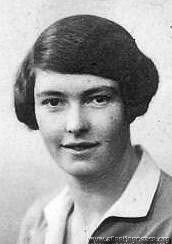 photo: 1927, aged 28
photo: 1927, aged 28 .jpg)
b. 26 November 1899 in Brooklands, Cheshire; her father was director of a firm of butchers.
She said she learnt to roll her own cigarettes at the age of five; expelled from school at age fourteen (for writing 'the headmistress can go to hell' on the toilet wall), she made her first flight in 1919 from Blackpool sands.
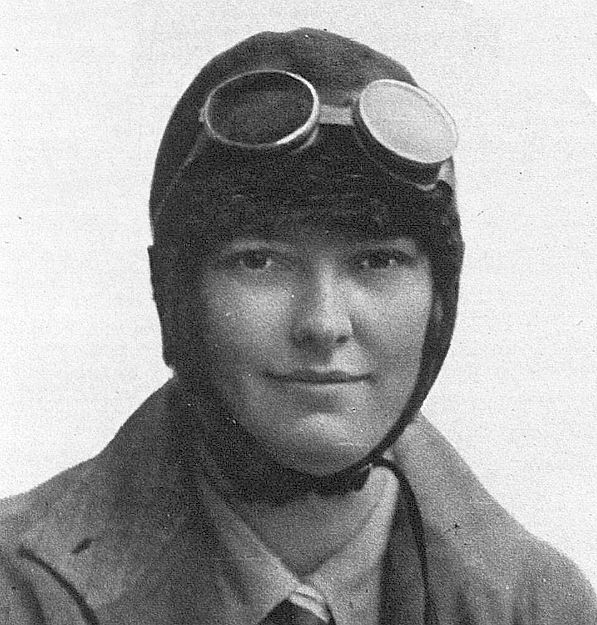 "A Well-known English Pilot" - The Sketch, 1929
"A Well-known English Pilot" - The Sketch, 1929First woman to win the King’s Cup (in 1930); well known in Lancashire as a hockey player who kept goal for the county and toured Australia with an English team; also a pretty good golfer, sailor and tennis player.
To see her being thoroughly embarrassed by her reception back at the Lancs Aero Club after winning the King's Cup, and to hear her say “Thank you for this welcome, it’s awfully good of you and I’m awfully happy to be back again in Lancashire, at the aerodrome where Captain Brown taught me to fly…. I’m delighted to have won the race and, well, thank you all very very much, I can’t say any more”, see here
.jpg)
Her son, Tony, b. 11 December 1940 in Angelsey, is "loved and remembered by millions as slippery Adam Chance in Crossroads".
She owned:
the 1928 Avro 594 Avian III, G-EBVZ - which her father bought for £500 - in which she won the King's Cup in 1930, then
a 1930 Avro 616 Sports Avian, G-ABED.
'Win' died in July 1984 in Hove, Sussex.
And you can now get a proper biography, entitled "WINIFRED BROWN: Britain's Adventure Girl No. 1", written by King's Lynn's most famous living author, Geoff Meggitt.
See www.pitchpole.co.uk for details!
b 26 November 1899 in Brooklands, Cheshire; her father was director of a firm of butchers.
Learnt to fly in 1926, but in 1928 was the pilot in a horrific accident when she was duped into a publicity stunt by Walter Browning, the 'Dancing Airman', who told her a film had to be delivered urgently, and persuaded to land her Avian in a field. She was surprised to see a crowd of people, realised she wasn't going to stop in time and tried to take off again, but hit the crowd standing near a wall; a 10-year old boy was killed, several persons injured, and "many women fainted". It turned out that the 'urgent film' never existed, just an empty box. She was exonerated of any blame.
First woman to win the King’s Cup, in 1930. She became an instant star across the world, especially in her home city of Salford. Invited to the 1930 Historical Pageant at Buile Hill Park shortly after the race, crowds chanted for a speech to be made. Winifred said “This is really wonderful of you all, I am very glad to belong to Salford” which prompted one audience member to start a sing along of ‘for she’s a jolly good flyer’. The Mayor of Salford congratulated Winifred on behalf of the people, and joked “No man begrudges you your honour and you have put us all back in our place”.
Before the Race, she was "well known in Lancashire as a hockey player who keeps goal for the county and has toured Australia with an English team".
One of the guests of honour at the Ladies Night dinner of the Press Club in December 1930; the chairman reckoned that "Women had forced their way into the columns of the Press, and now they seemed to be on the way to monopolizing them".
She was still an active ice hockey player in 1933, flying herself from Manchester to London to take part in the Sheridan Cup, where she kept goal for the "Queen's Ladies". She was also a pretty good golfer; she and her partner Mrs Brooks got to the last 8 of the Ladies' Northern Foursomes at Leeds in 1938.
Later sailed from North Wales to Spitsbergen in her 45-foot yawl Perula. During WWII, Chief Coxswain in the Marine Department of Saunders Roe.
In 1940 she gave birth to a son, Anthony, after it was revealed she had "secretly married her long time adventure companion Ron Adams" (although I'm not sure what was so secret about it).

She attended the 1950 King's Cup Race, but was "horrified ... I thought sadly of Bert Hinkler, Cobham, Barnard, Hubert Broad and Wally Hope."
'Win' died in July 1984 in Hove, Sussex.
Winifred Brown was born [26 November] 1899 in Brooklands, Cheshire. She moved to Salford at an early age and went on to attend ‘Bella Vista’, Broughton High School for Girls. Winifred’s father, Mr Sawley Brown, was director of Messrs. James S. Brown & Sons, a firm of butchers.
Winifred was a natural sportswoman, and achieved great success in flying when she became the first woman to join the Lancashire Aero Club in 1926 and the first woman in the region to qualify for a pilot’s licence in April 1927. By March 1928 Winifred was recruited to the rank of a private owner member, and that same year she won the club’s Rodman Trophy.
By the 1930 King’s Cup Air Race, a 750mile race around England, Winifred Brown was an experienced pilot, although she had never flown such a long distance. In the pre-race articles that appeared in Flight magazine, on June 13 1930,Winifred’s entry was not taken seriously, mentioned with six other pilots of the ‘fairer sex’ only briefly. Winifred flew an Avro Avian with a Cirrus III engine with her co-pilot, and later husband, John Ron Adams. The Air Race was full of excitement, after starting the race at Hanworth, London. By the time she reached Barton Aerodrome, Winifred was in third position and the large crowds roared with excitement. The final finish was at Newcastle, by which time she’d run away with the lead. There was a dramatic finish when Winifred spotted a large aircraft behind them. Believing it to be a competitor and determined not to be beaten to the finish line, the Avian was pushed to speeds of 160 miles per hour! Afterwards a mechanic told the Salford Reporter that this speed ‘was courting disaster’. By pushing her Avian to the limits Winifred beat her male contemporaries, including Flight Lieutenant Waghorn, winner of the prestigious Schneider Cup.
As the first woman to win the King’s Cup, Winifred became an instant star across the world, especially in her home city of Salford. Invited to the 1930 Historical Pageant at Buile Hill Park shortly after the race, crowds chanted for a speech to be made. Winifred said “This is really wonderful of you all, I am very glad to belong to Salford” which prompted one audience member to start a sing along of ‘for she’s a jolly good flyer’. The Mayor of Salford, Samuel Finburgh, congratulated Winifred on behalf of the people, and joked “No man begrudges you your honour and you have put us all back in our place”(Salford Reporter 11 July 1930).
Winifred’s later adventures in the 1930s went beyond Britain, this time sailing rather than flying from North Wales to Spitsbergen in her 45-foot yawl Perula. During the Second World War, Winifred worked as Chief Coxswain in the Marine Department of Saunders Roe, the flying boat constructors in Beaumaris. Winifred worked with a fleet of R.A.F. craft with all-male crews, she met Catalinas from Bermuda, landed and embarked crews and towed aircraft.
In 1940 she gave birth to a son, Anthony Sawley Adams, after it was revealed she had secretly married her long time adventure companion Ron Adams.
With thanks to John B. Coxon and Tony Adams
In 1950, Winnie wrote this lovely article for 'Flight':
POST-WAR AIR RACING - is Something Missing?
A Pre-war Winner Asks Some Pertinent Questions
By WINIFRED BROWN
As something "rather different" in post-war air races, the Daily Express "International South Coast Race" on September 16th seems likely to be watched with interest, especially by "the forgotten pioneers of long ago" - in which category a South African magazine recently included me!
For some time we have been asking ourselves " What has gone wrong - air racing or we old pilots?" Has the sport really lost its thrill and popularity, or have we merely become the club bores who stand at a bar counter and say, between beers, "Things aren't what they were"?
I have been thinking about these questions for several weeks - ever since, in fact, I set off, in excited anticipation and an Austin Seven - to see this year's King's Cup Race. The Wolverhampton Aero Club had very kindly invited me - "Just to show them you are still in the land of the living, Win?" chuckled John Bill over the telephone, for the previous year the B.B.C. had coupled my name with the type of wings that go with a harp! It was 20 years since I had won the King's Cup and 19 years since I have even seen an air race. I had a shock coming to me!
When asked if I were flying, I laughed and replied ungrammatically, "What, me! I'm used to 105 m.p.h.,not 501." And as my little car proceeded at a sedate 40m.p.h. my mind went back 20 years. Who would be there? Tommy Rose, Jimmy Jeffs, Robin Cazalet, "Lamps"? What fun it would be to see them all again!
On arrival at the Star and Garter I rushed to look at the hotel register... I didn't recognize a single name! They must still be in the bar... we had always lingered... they would come later; so, casting respectability to the wind, I ignored my married name and wrote " Win Brown and son."
That night there was a R.A.F.A. dance - to meet the "famous pilots"! The dancing was popular enough, but we were not; when we went on the stage the room practically emptied - the dancers had probably done far more flying than we had!
Still there was a nice bar upstairs, and I talked with interest to the 1950 pilots. "Do you have flying pageants these days?" I asked a young man. For a moment he looked puzzled, then replied "Yes, but we call them 'air rallies'". When I flew in 1930 we had a 750-mile course. Do you like these short circuits? " "Oh yes! It's a better test of flying—none of this navigation stuff enters into it. '
I thought sadly of Bert Hinkler, Cobham, Barnard, Hubert Broad and Wally Hope. That night I went to bed at 11.30 - if there was a party I didn't find it!
Next day I got to the airfield early. I looked and blinked. Was I back in 1930? Where were these modern super aircraft? I felt I could have got into almost any one of the competing machines, and flown as I used to do; but my son, aged nine, was thrilled as I took him round. It was then the Press descended on us - "That's right,sonny - smile up at your grannie!'' My expression was such that the pictures did not appear, but fortunately the bar tent opened and Jack Cantrill, who had given me my first flying lesson in 1925, assisted me to recover.
Then a few old faces appeared, but we all sadly agreed that "things ain't wot they was." As for the race itself - well, it sounded fine on the radio but, with no rudeness intended, I would not describe Hawk Trainers and Austers "screaming" round anything. Princess Margaret's Hurricane gave us a thrill and it was beautifully handled by Townsend, but the two Spits that I hadrelied on to impress my son promptly took off and got lost - so perhaps there is something in this ''navigation stuff" after all! One we never saw again, but the other obligingly returned, much to the delight of my small son, and the spectators - but probably less so to the owner of the aircraft whose tail it knocked clean off.
But what horrifies me about this race - and, for that matter, present-day air racing in general - is that the slide-rule experts, secreted with Charles Gardiner in glass towers, seem reasonably able to forecast the result after one lap! In the King's Cup they were about 60 yards out, and in the two Newcastle races a few weeks later it seems from Flight's report that the ultimate winners appeared unbeatable almost from the outset.
Where is the sport, the fight, the fun of the thing? It seems to me that if you haven't beaten the handicappers before you start you might just as well stay in the bar. On a long circuit a race was never lost until it was won. Engines could pack up in sight of home; flimsy racing wheels could buckle on a careless landing; you might run into cloud or fog and fail to find that white cross in the field; but no matter what happened there was always home - the others might be faring worse. To beat the handicappers was a decided help, but only the beginning of a long story.
After this year's King's Cup I scanned the newspapers, but gone were the old headlines. The little publicity there was went to the tragic accident rather than to Edward Day. I wondered vaguely if a victory for Princess Margaret would have received more publicity, but I doubt it - my papers were full of the footballers who received a free trip to South America, £25 each and the offer of some £175 a month, and returned highly incensed because a hair-cut cost 7s and the people carried rifles!
So good for British prestige, and obviously so much more important than a few men and women who risk their neck for British aviation, a possible prize of £150 and a replica of the Cup. I did risk my neck for about £1,000 in 1930, and in those days the cup was won outright.
What has caused this lack of interest on the part of the Press and public? Has flying become too common? But, for that matter, what could be more common than football and race-horses, sports which still hold the crowds? Perhaps it is the effect of the war - petrol only just off the ration, money short, private owners and aero clubs unable to afford the high-powered aircraft we now scarcely glance at as they do, literally, scream through the sky.
Presumably with the industry in a transition stage pending large-scale production of military jet aircraft, and because of present-day-economic conditions, the trade cannot give the support it did to racing. For this reason one must admire the present-day private owner. Gone are the days of dual at £1 an hour, free petrol, a loaned engine, and perhaps even a free aircraft. To-day one can hardly afford to patronize the bar tent!
My small son was all for presenting the King's Cup to Cole and his Comper Swift. ''That little one has done best, Win - t has gone all that way against the big ones." Out of the mouths of babes and sucklings.... Would the old Circuit of Britain again arouse public interest? Personally, I think it would. Some 15,000 people were present at Wolverhampton this year, but in 1930 similar, if not larger, crowds assembled at each of the controls at London, Bristol, Manchester, Newcastle and Hull, not to mention the turning-points at Southampton, Birmingham,Liverpool, Leeds and Leicester. The King's Cup race belonged to the country as a whole and not just to one area.
But there is another point, and an important one. The rot started to set in way back in 1931, when new King's Cup regulations caused the entries to drop from 101 to 41. Restrictions! They are ruining our country to-day. It seems to be that the South Coast Race is, in some degree, a return to old conditions, and that if it is successful it may influence next year's King's Cup. I hope so, for personally I would like to see a grand and glorious free for all - Maggies to Meteors on the old circuit of Britain.
''What else would you do, Win?" asked one of the old timers as we stood discussing the matter in the bar. "I'd have bookies under nice, coloured umbrellas - but I'd keep them away from the slide-rule experts!" And I suppose you'd have better prizes and bigger bar tents? "Sure!" I laughed. "Well," said an old pilot, slowly, "something has got to be done; the King's Cup to-day is no different to the little races we used to take part in every Saturday at the old pageants." "Rallies, dear, rallies," I corrected.
So we all had another beer, and my small son, waiting outside, began to take a dim view of aviation.
-
Bruce, T B
Flt-Lt T B Bruce
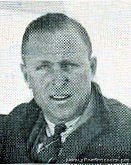
photo: 1930
-
Buckley, James Brian
Mr James Brian Buckley DSC b. 1905.
Royal Navy Service Pilot, attached to HMS Courageous in 1930.
Killed in WWII: 21st March 1943, when Lieut-Commander, RN on HMS Glorious; buried at Lee-on-Solent.
-
Butler, Alan Samuel
Mr Alan Samuel Butler J.P. 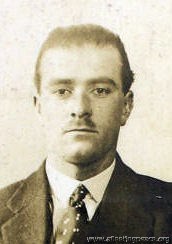
photo: 1921, aged 23
Chairman of de Havilland; the story goes that in 1921 he asked the one-year old de Havilland Aircraft Company to build a fast two-passenger touring aeroplane to his specification,
and stumped up £3,000 for them to do it. The money saved the company from extinction and they appointed him to the board of directors forthwith. He held the position until he retired in 1950.
The aeroplane became the DH37, (which he named, firstly, 'Sylvia' after his sister, then, rather diplomatically, 'Lois', after his wife, q.v.), which he entered in the very first King's Cup Race in 1922 and again in 1924, coming third.
He and Lois set up a world speed record of 120mph for 1000 km in 1928, and they also flew to Cape Town together .
Entered the MacRobertson Race in 1934 (assigned No 59) but didn't take part.
Was still aviating in 1970.
-
Butler, Lois
Mrs Lois Butler
Royal Aero Club Certificate 8634 (14 Jun 1929)
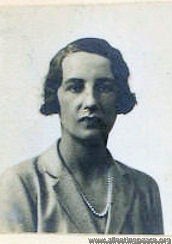
Née Reid
b. 3 Nov 1897 in Montreal, Canada; the "beautiful" [so said Harald Penrose] wife of Alan Butler.
(later, the 'Flying Grandmother', oh well...)
Her first husband having died in 1923, she married Alan Butler in 1925; together they had a daughter and a son.
15th in the Women’s Combined Alpine Skiing at the 1936 Winter Olympics, skating for her native Canada (although she was a member of the British Team before that).
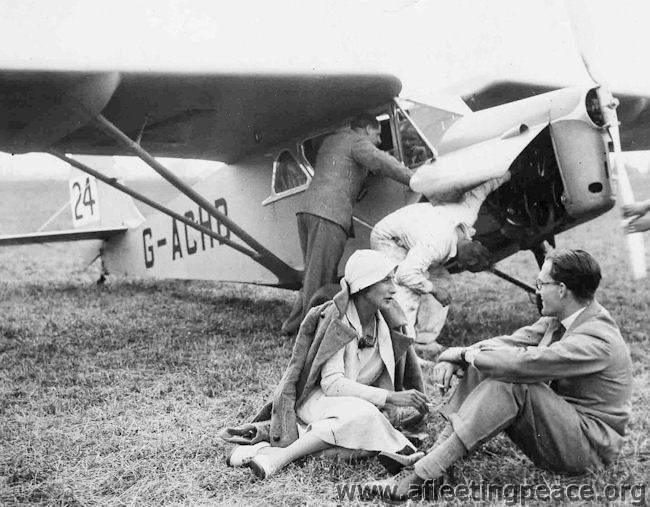 King's Cup 1933
King's Cup 1933Post-WWII, the Butlers moved to Rhodesia and bought a tobacco farm, but eventually moved back to Studham Hall, Bedfordshire.
She owned a 1930 DH.80A Puss Moth G-ABGX, which was sold in France in December 1934, re-registered as F-AMRX and whose registration was finally cancelled in 1936.
d. 17 Aug 1970 in Piraeus, Attiki, Greece from a heart attack while on holiday, and is buried in Studham.
-
Cantrill, John Conway
Mr John Conway Cantrill
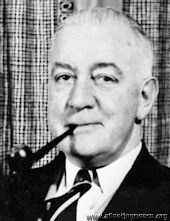 in 1961
in 1961'Jack', b. 28 May 1898 in Manchester.
Manchester University OTC then RFC (Admin Dept) during WWI, later test pilot for Avro. Volunteer instructor with the Lancashire Aero Club and, from 1930, Manager of Aviation Dept of Cellon [manufacturer of aircraft dope and finishes].
In 1925, "Mr. Cantrill, having no pupils down at the aerodrome, spent the afternoon shooting and returned with two good hares. This shooting is becoming a popular pastime for those who are waiting to fly."
Taught Winnie Brown to fly; rejoined the RAF in December 1939, again in the Administrative and Special Duties Branch.
In 1944 he resigned his commission as a Wing Commander, and rejoined Cellon.
d. 1978 on the Isle of Wight.
-
Carnegie, David Vaughn
Flt-Lt (later Sqn-Ldr) (Sir) David Vaughn Carnegie KBE CB AFC
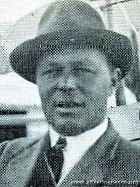
photo: 1930
One of the most experienced flying-boat pilots in the country: 3,000 hours by 1931.
RNAS during WWI, then flew in and around the Mediterranean and the Far East; spent 18 months as honorary instructor to the Singapore Flying Club.
Later an Air Vice Marshall.
-
Cazalet, Robert George
Capt Robert George Cazalet 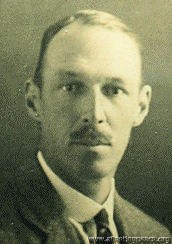 photo: 1927, aged 35
photo: 1927, aged 35 -
Chalmers, John William Pender
Mr John William Pender Chalmers
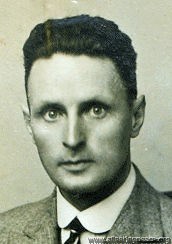
photo: 1928, aged 40
born in Morro Velho, Brazil -
Cochrane, Ralph Alexander
Ralph Alexander Cochrane 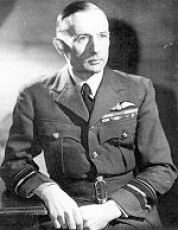
b. 1893
later Air Chief Marshall The Hon R Cochrane.
In 1930, he was at the RAF Staff College.
-
de Havilland, Geoffrey
Capt (later Sir) Geoffrey de Havilland O.M. K.B.E A.F.C Hon.F.R.Ae.S
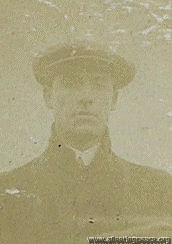 1911, aged 29
1911, aged 29 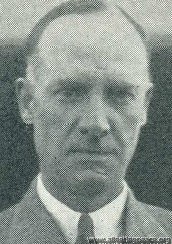 1936, aged 54
1936, aged 54Geoffrey de Havilland - Wikipedia has his story -
de Havilland, Geoffrey Raul
Mr Geoffrey Raul de Havilland
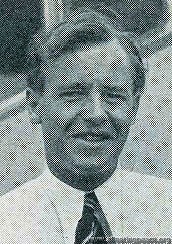 1936
1936Geoffrey Junior, aka 'Young D.H.' born in 1910 and learnt to fly at Stag Lane at a tender age. Took over as chief test pilot at de Havillands when Bob Waight was killed.
Second Brit to fly a jet-propelled aircraft on its first flight, the Vampire in 1943. Killed when the second DH108 Swallow broke up and crashed in the Thames estuary in 1946.
Flight 18th April 1946
As a test pilot young D.H., as he is universally called,has not an exceptionally long history. He took over the chief test pilot's position in October, 1937, when R. J. Waight unfortunately lost his life on the T.K.4. Being, however, the son of his illustrious father, Sir Geoffrey de Havilland, who designed, built and test flew his own aircraft from 1911 onwards, young Geoffrey can be said to have been ''in the industry'' from the very cradle. It is not generally known that Sir Geoffrey took his R.Ae.C. ticket No. 53 in February, 1911, on the second machine of his own design and construction, and that he has made many of the first flights on new D.H. types right up to the Moth Minor in 1938.
Geoffrey's first flight is lost in the dim past, but certain it is that at the tender age of six he was flying with father at Hendon in a D.H. 6 (also known as the Clutching Hand). When 18 years of age he left school and came to de Havillands as a premium apprentice for 4 years and learnt to fly on Moths at the firm's reserve training school. After spending two years in the drawing office—much of the time being spent looking out of the windows envying the pilots—he joined the Air Operating Company, who were doing a lot of air survey work in South Africa. This, however, gave him but very little flying, and at the end of six months, he came back to England to become a flying instructor to the D.H. Technical School. The aircraft were wooden Moths built by the students. In 1929 he took his B licence; a very simple business in those days. Some 20 or 30 hours' solo flying, a little cross-country work, a simple "Met" exam, and about one hour's night flying at Croydon was sufficient to qualify.
In 1934 Capt. Hubert Broad was chief test pilot of de Havillands, and Bob Waight looked after the production side. There was so much work, however, that Geoffrey was given the opportunity to lend a hand testing Tiger Moths, Dragons, Rapides, Express Air Liners, and Hornet Moths.
Broad left the company in 1935 and Waight took over, starting, with the Dragonfly and later the Albatross. It was during the period when the prototype Albatross was going through its development flying that Waight lost his life, and de Havilland took over as chief test pilot. Nobody could have taken on a more interesting or more complex job because the Albatross was completely experimental from tip to tail. Engines were new, construction was new, and the layout was extremely advanced.
He had a curious experience on the Albatross. While its strength was ample for all flying loads, some unfortunate drilling had weakened the fuselage under ground loads, and shortly after landing from a test flight the machine broke in halves on the ground.
When war broke out lie was busy testing Oxfords and Flamingoes, but when things became desperate at the time of the Battle of Britain, de Havillands did a big job doing emergency repairs to shot-up Hurricanes.
Dick Reynell of Hawkers came over and gave Geoffrey the "know how" on Hurricanes. A little later Dick went out on operations with his old squadron (No. 43) and was, unfortunately, shot down.' He was an excellent test pilot and a gallant gentleman.
Improvised Runway
Geoffrey flew the first Mosquito at Hatfield on November 21st, 1940, but he is more proud of the first flight of the prototype Mosquito fighter. This was built at a dispersal factory with no airfield. To save some six week's wasted time in transport and re-erection at Hatfield, Geoffrey used local fields by having bridges built over ditches to give him a 450yd run for take-off, and then flew the fighter to Hatfield.
He is, of course, one of the only two men in Britain to have made first flights on jet-propelled aircraft. The Vampire was flown for the first time on September 21st, 1943, but Geoffrey had already flown the Gloster E.28 at Farnborough. The first airing of the Vampire proved it to be a tribute to the D.H. design and aerodynamics staff, as it behaved almost exactly as they had forecast. There was, however, somewhat of an aileron overbalance which limited the speed to 250 m.p.h. and a rather severe tip stall.
Geoffrey de Havilland had made a number of investigation flights on Mosquitoes for compressibility effects, but on the Vampire he has done extensive work. The Vampire, under the effects of compressibility, executes a series of sudden high-speed stalls: the path of the machine is similar to an artist's conception of a streak of lightning, and unless the pilot is strapped-in tightly he is likely to be knocked out by hitting the cockpit roof.
Geoffrey, with another pilot, has flown the Vampire in tight formation at over 500 m.p.h., and to investigate snaking, which is causing considerable trouble on most jet aircraft, he has flown the Vampire with rudder locked.
Like most of the test pilots, he is living on borrowed time, they having at some stage of their careers had close shaves. Strangely enough, Geoffrey's nearest go was on about the mildest type he ever flew. It was the first production Moth Minor. The prototype had completed its spinning tests, and the same tests on the production model appeared to be only a matter of form. He was flying with John Cunningham (now Group Capt., D.S.O.,D.F.C., and test pilot for the D.H. engine division) at the time. The Minor was put into a spin at 5-6,oooft, but after it had failed to come out in five turns and the engine had stopped, a panic decision was made to abandon ship.
Test-flying a Hurricane, too, almost saw him off. This particular aircraft had had a gruelling time in the Battle of Britain, and the whole canopy came off at 4,000ft.hitting him in the face as it blew backwards. At first blind through the amount of blood in his eyes, he flew more by instinct than anything else until he found he could get a little relief by holding his face close to the instrument board. The blood dispersed a little and he was able to land through what appeared to be a thick yellow haze. He wears the scars across his nose to this day, and there was a terrible moment during that flight when he thought he was really blind.
On another occasion the oxygen bottle contained only compressed air, and the effects from this were at first blamed on the previous night's party.
At the other end of the scale was the test of the T.K.5, a tail-first aircraft built by the technical school. Impecunious at the time, Geoffrey had already mortgaged the bonus for the first flight. Imagine his consternation then when, after roaring the whole length of Hatfield airfield, the machine showed no sign of lifting. The forward elevator was ineffective. The T.K.5 never did fly and was finally abandoned.
In the days of peace before the war Geoffrey de Havilland was to be seen at all the air meetings and twice finished 4th in the King's Cup Race flying the TK1 and TK2.
-
Don, David Sigismund
Sqn-Ldr David Sigismund Don 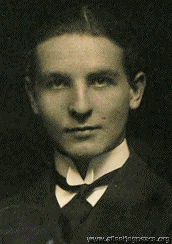
photo: 1914, when a midshipman in the Royal Navy, aged 18
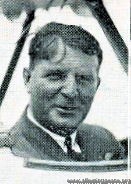
photo: 1930, aged 34
Page 1 of 5

